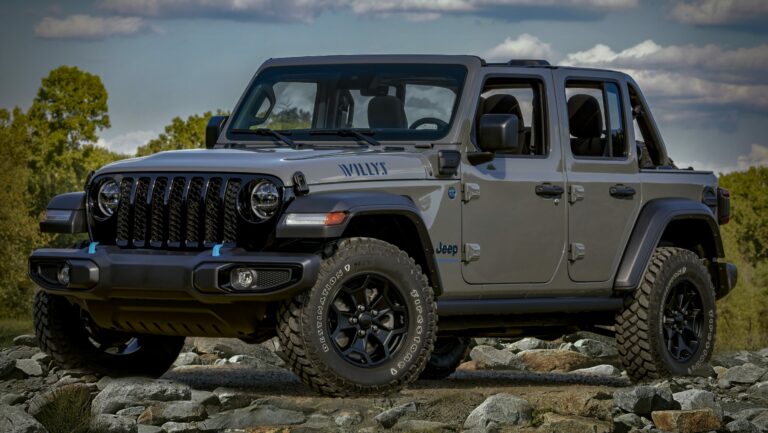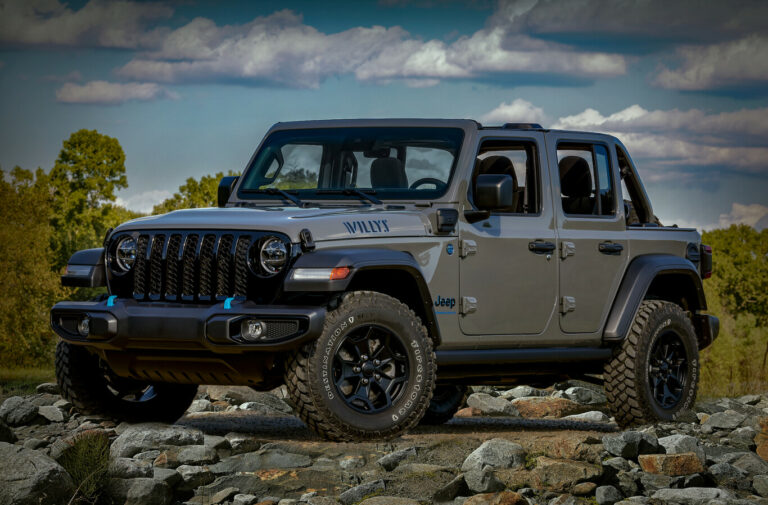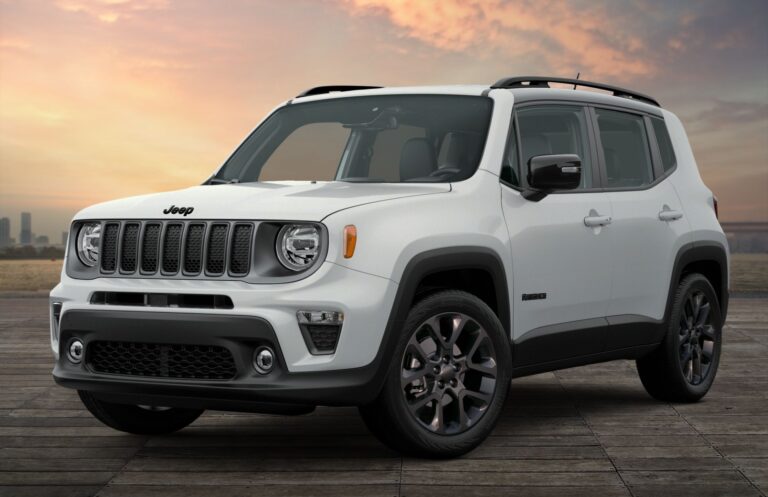1946 Willys Jeep CJ-2A For Sale: A Comprehensive Buyer’s Guide to an American Icon
1946 Willys Jeep CJ-2A For Sale: A Comprehensive Buyer’s Guide to an American Icon jeeps.truckstrend.com
The year is 1946. World War II has just concluded, and a nation weary of conflict is eager to rebuild and embrace peacetime innovation. From the ashes of military production emerges a vehicle that would revolutionize civilian utility and recreation: the Willys Jeep CJ-2A. Often hailed as the "Universal Jeep," the CJ-2A was Willys-Overland’s first dedicated civilian-production Jeep, taking the battle-proven design of the MB and adapting it for farms, ranches, and burgeoning suburban life. Today, the 1946 Willys Jeep CJ-2A remains a highly sought-after classic, cherished by collectors, off-road enthusiasts, and history buffs alike.
For anyone considering a "1946 Willys Jeep CJ-2A For Sale," this article serves as your definitive guide. We’ll delve into its enduring legacy, what to meticulously inspect, how condition affects value, where to find these automotive treasures, and practical advice for navigating the purchase and ownership experience. Embarking on the journey to acquire a CJ-2A isn’t just buying a vehicle; it’s investing in a tangible piece of American history and an enduring symbol of rugged capability.
1946 Willys Jeep CJ-2A For Sale: A Comprehensive Buyer’s Guide to an American Icon
The Enduring Legacy of the CJ-2A: From Battlefield to Farm Field
The 1946 Willys CJ-2A stands as a monumental bridge between military necessity and civilian freedom. Building on the robust foundation of the wartime MB and Ford GPW, Willys-Overland strategically re-engineered the Jeep for peacetime applications. While the iconic flat-fender silhouette remained, the CJ-2A introduced several key civilian-oriented features that set it apart.
Gone were the blackout lights and military-specific fittings. In their place, Willys incorporated a tailgate (a revolutionary feature for a utility vehicle of its size), seven-slot grille, larger headlights, a side-mounted spare tire, and a host of optional power take-off (PTO) units designed to run farm equipment like plows, mowers, and even welders. Under the hood, the reliable "Go-Devil" L-134 flathead four-cylinder engine continued its duty, paired with a T-90 three-speed manual transmission and a Dana 18 transfer case for robust 4×4 capability.
The CJ-2A quickly found its niche, becoming an indispensable tool for farmers, ranchers, and construction workers. Its compact size, legendary durability, and unparalleled versatility made it an instant success, laying the groundwork for every civilian Jeep that followed. Owning a 1946 CJ-2A is more than just possessing a vintage vehicle; it’s preserving a piece of industrial heritage that shaped post-war America.
What to Look For: Essential Inspection Points When Buying a 1946 CJ-2A
Acquiring a vintage vehicle like the 1946 CJ-2A requires a keen eye and a methodical approach. Condition varies wildly, from fully restored showpieces to barn finds needing extensive work. Here’s a detailed checklist of critical areas to inspect:
- Chassis and Frame: This is paramount. Look for rust, especially near spring mounts, crossmembers, and the steering box. Check for bent, cracked, or poorly repaired sections from accidents or hard use. A solid frame is the foundation of a good Jeep.
- Body: Rust is the primary enemy. Pay close attention to the floorboards (especially under the driver’s feet), the hat channels (underneath the floor), the battery tray area, front fenders, cowl, and the tailgate. Look for signs of extensive bondo use or poor patch panel installations. Originality of the body tub can significantly impact value.
- Engine (Go-Devil L-134):
- Leaks: Oil leaks are common but excessive leaks indicate worn seals or gaskets.
- Starting & Running: Does it start easily? Does it idle smoothly? Listen for knocking, ticking, or excessive smoke from the exhaust (blue smoke indicates oil burning, black indicates rich fuel, white indicates coolant).
- Compression: A compression test is highly recommended to assess engine health.
- Cooling System: Check for leaks in the radiator, hoses, and water pump. Ensure the engine doesn’t overheat.

- Transmission (T-90) & Transfer Case (Dana 18):
- Shifting: Test all gears, including reverse. Listen for grinding or difficulty engaging.
- 4×4 Engagement: Engage 4-high and 4-low. Ensure the transfer case shifts smoothly and the 4×4 system works correctly.
- Leaks: Check for fluid leaks from both units.

- Axles (Dana 25 Front, Dana 41 or 44 Rear): Listen for howling or grinding noises during a test drive, which could indicate worn gears or bearings. Check for fluid leaks at the differentials and wheel ends.
- Steering & Suspension:
- Steering Play: Excessive play in the steering wheel indicates worn tie rod ends, drag link, steering box, or kingpins.
- Suspension: Check leaf springs for sagging or broken leaves. Inspect shocks for leaks or damage.
- Electrical System: Original 6-volt systems can be finicky. Check all lights, gauges, and the horn. Look for frayed or aftermarket wiring, which can be a fire hazard. Many have been converted to 12-volt, which is a common and often beneficial modification.
- Brakes: Test the brakes thoroughly. Check the master cylinder for leaks, and inspect brake lines and drums for wear or damage. Remember, these are drum brakes all around, so performance will not match modern vehicles.
- Originality vs. Modifications: Decide what’s important to you. A highly original, numbers-matching CJ-2A commands a premium, but well-executed, period-correct modifications (like a 12-volt conversion or a slightly larger engine) can enhance usability without drastically reducing value for some buyers. Avoid heavily customized or "franken-Jeep" builds unless you’re specifically looking for a project.

Understanding Condition Grades and Their Impact on Price
The price of a 1946 Willys CJ-2A varies significantly based on its condition. Understanding these grades is crucial for setting expectations and negotiating.
| Condition Grade | Description | Estimated Price Range (USD) |
|---|---|---|
| Concours/Show | Flawlessly restored to original factory specifications or better. Every detail is correct, paint is perfect, mechanicals are rebuilt to new. Ready for competitive showing. | $30,000 – $60,000+ |
| Excellent/Driver | Very good overall condition. Mechanically sound, reliable, and presentable. May have minor imperfections from use, but no major rust or mechanical issues. Suitable for regular enjoyment and local shows. | $18,000 – $30,000 |
| Good/Project | Running and driving, but needs significant cosmetic and/or mechanical work. May have some rust, worn interior, or minor mechanical issues that require attention. Can be enjoyed as-is with a focus on future restoration. | $8,000 – $18,000 |
| Fair/Parts Vehicle | Non-running, extensive rust, significant mechanical issues, or missing major components. Primarily suitable for parts or a complete frame-off restoration requiring substantial time and investment. Often found as "barn finds." | $3,000 – $8,000 |
Note: These are estimated ranges and can fluctuate based on location, specific features (e.g., PTO, original hardtop), historical documentation, and market demand.
Where to Find a 1946 Willys CJ-2A For Sale
Finding the right CJ-2A requires patience and knowing where to look:
- Online Marketplaces: Websites like eBay Motors, Craigslist, Facebook Marketplace, and dedicated classic car sites (e.g., Hemmings, ClassicCars.com) are excellent starting points. Be wary of scams and always verify listings.
- Classic Car Dealers: Many dealerships specialize in vintage vehicles. While prices might be higher, they often offer inspected vehicles and sometimes warranties.
- Auctions: Major auction houses (Mecum, Barrett-Jackson, RM Sotheby’s) occasionally feature CJ-2As, particularly high-end restored examples. Local classic car auctions can also be a source.
- Willys/Jeep Clubs & Forums: Enthusiast communities (online forums, local clubs) are invaluable resources. Members often know of vehicles for sale within their network, and you can get advice from experienced owners.
- Word of Mouth: Sometimes the best deals are found through casual conversations. Let friends, family, and mechanics know you’re looking.
Navigating the Purchase Process: Tips for Buyers
Once you’ve found a potential CJ-2A, here’s how to proceed:
- Set a Realistic Budget: Beyond the purchase price, factor in costs for transport, immediate repairs, registration, insurance, and potential future restoration.
- Do Your Research: Learn about the specific year’s characteristics. Understand VIN decoding for CJ-2As to verify authenticity. Ask the seller for any historical documentation, maintenance records, or restoration photos.
- Get a Pre-Purchase Inspection (PPI): If possible, have a qualified mechanic with vintage Jeep or classic car experience inspect the vehicle. This objective assessment can uncover hidden issues and save you significant money down the line. If an in-person inspection isn’t feasible, ask for detailed photos and videos of specific areas.
- Negotiate Effectively: Armed with your inspection findings and market research, be prepared to negotiate. Don’t be afraid to walk away if the price doesn’t align with the vehicle’s condition.
- Understand Titling and Registration: Vintage vehicle laws vary by state/country. Ensure the seller has a clear title that matches the vehicle’s VIN.
- Arrange Transport: Unless you plan to drive it home (only recommended for truly excellent, thoroughly inspected vehicles), arrange for professional enclosed transport to protect your new acquisition.
Owning a 1946 Willys CJ-2A: Maintenance and Enjoyment
Owning a 1946 Willys CJ-2A is a unique and rewarding experience. These vehicles are surprisingly robust and relatively simple to maintain, making them an excellent choice for a first-time classic car owner.
- Parts Availability: You’ll be pleased to know that parts for CJ-2As are surprisingly good. Many mechanical components (engine, transmission, transfer case, axles) were used for years across different models, and a thriving aftermarket exists for reproduction body panels, electrical components, and trim.
- Basic Maintenance: Adhere to regular oil changes, lubrication of chassis points, and checking fluid levels. The "Go-Devil" engine is forgiving but appreciates proper care.
- Join a Community: Connect with other CJ-2A owners through local clubs or online forums. They are an invaluable source of knowledge, tips, and camaraderie.
- Embrace the Experience: Driving a CJ-2A is unlike anything modern. It’s raw, engaging, and slow by today’s standards, but offers an unparalleled connection to the road and the vehicle’s history. Take it to local car shows, on scenic backroads, or even light off-road trails to truly appreciate its capabilities.
Frequently Asked Questions (FAQ)
Q: Are parts readily available for a 1946 CJ-2A?
A: Yes, surprisingly so! Many mechanical components are shared with later Jeeps and other period vehicles. Reproduction body panels, electrical parts, and engine components are also widely available from specialized vendors.
Q: Is it difficult to drive a vintage Jeep?
A: It requires some adjustment. CJ-2As have manual steering (heavy at low speeds), manual drum brakes (require more effort), and a non-synchromesh first gear (meaning you typically start in second or double-clutch into first). They are not fast, but once you get the hang of it, they are incredibly fun and rewarding to drive.
Q: What’s the fuel economy like?
A: Expect around 15-20 miles per gallon (MPG) under ideal conditions. It’s not a commuter car, but for its age and utility, it’s respectable.
Q: Can I use it as a daily driver?
A: While mechanically robust, a 1946 CJ-2A is generally not recommended as a daily driver due to its age, lack of modern safety features (no airbags, basic seatbelts), slower speeds, and unique driving characteristics. It’s best enjoyed as a weekend cruiser, utility vehicle, or showpiece.
Q: What’s the difference between a CJ-2A and a military MB?
A: While similar, the CJ-2A introduced civilian features like a tailgate, larger headlights, a side-mounted spare tire, a civilian dashboard layout, and typically a 6-volt electrical system (MBs were 24-volt). The CJ-2A also lacked military-specific blackout lights and fittings.
Q: How much does it cost to restore one?
A: A full, professional frame-off restoration can easily range from $20,000 to $50,000+, depending on the starting condition, desired level of originality, and labor rates. Many owners opt for a rolling restoration, tackling projects over time.
Conclusion
The 1946 Willys Jeep CJ-2A is more than just an old vehicle; it’s a living testament to American ingenuity and resilience. Its rugged simplicity, iconic design, and historical significance make it an incredibly appealing classic for those seeking a tangible connection to the past. Whether you’re looking for a meticulously restored showpiece, a reliable weekend driver, or a rewarding restoration project, the journey of finding and owning a CJ-2A is an adventure in itself.
By thoroughly researching, inspecting, and understanding the nuances of these vintage machines, you can confidently acquire a piece of automotive legend that will provide years of enjoyment and a unique driving experience. Embrace the history, cherish the simplicity, and join the proud lineage of Willys Jeep owners.






